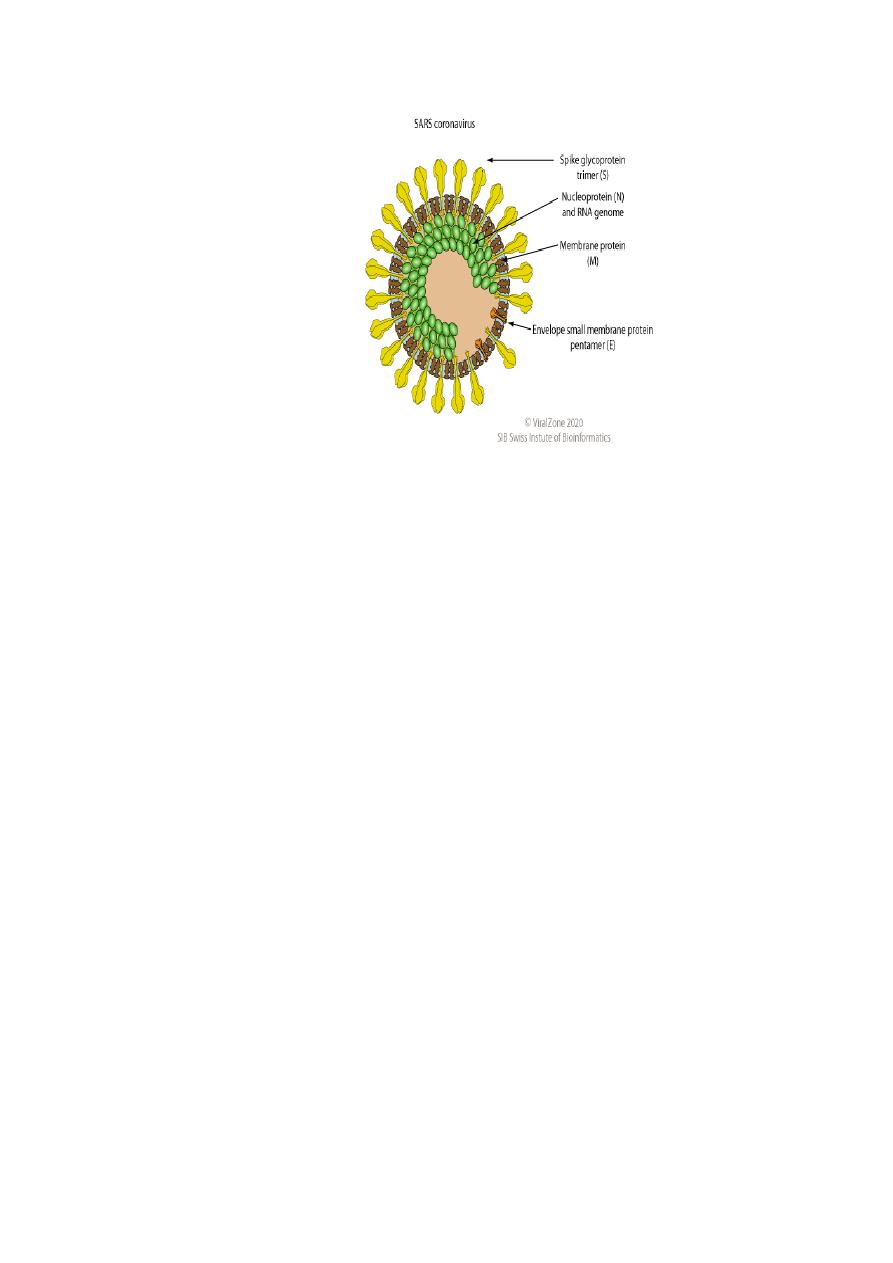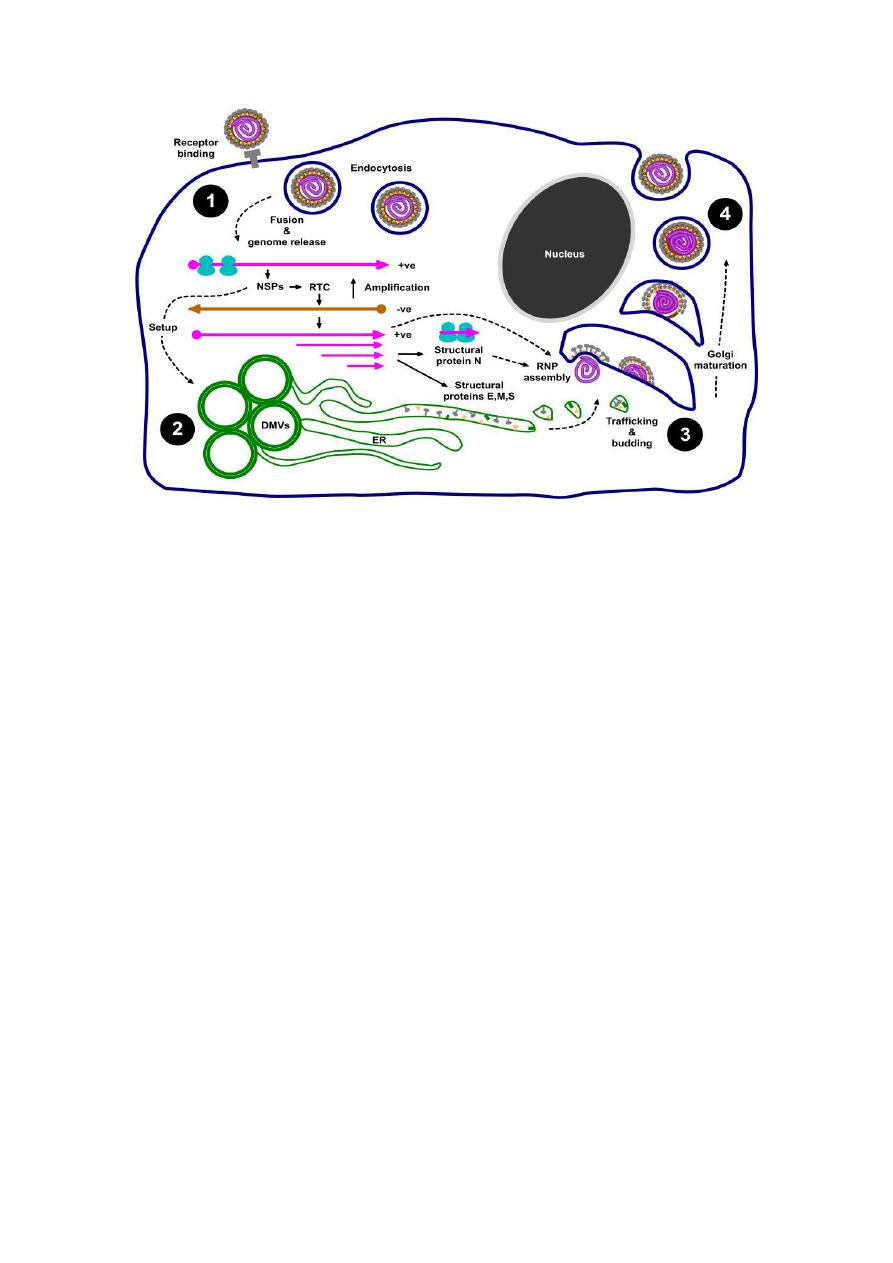
1
Coronaviruses
اﻟﻤﺮﺣﻠﮫ اﻟﺜﺎﻟﺜﮫ /ﻓﺎﯾﺮوﺳﺎت
د. اﻧﺘﻈﺎر ﻋﻼوي ﺟﻌﻔﺮ / ﻓﺮع اﻻﺣﯿﺎء اﻟﻤﺠﮭﺮﯾﮫ / ﻛﻠﯿﮫ اﻟﻄﺐ / ﺟﺎﻣﻌﮫ ذي ﻗﺎر
PhD. M.Sc. Microbiology
Introduction
Coronaviruses (CoVs) are enveloped +ve sense RNA viruses causing a variety of
diseases in man and animals. In Humans, several CoVs are known to cause
respiratory infections ranging from the common cold to more severe diseases.
CoVs are considered to be the largest of the RNA viruses, with genomes ranging
from 27-32 kb . Viruses of zoonotic potential are found within the coronaviruses
as exemplified by Severe Acute Respiratory Syndrome coronavirus (SARS-CoV)
which emerged in Southern China in 2003 , Middle East Respiratory Syndrome
(MERS-CoV), which appeared in Saudi Arabia in 2012 and the most recently
SARS-CoV-2 in Wuhan China in 2019 causing COVID-19 disease.
Coronavirus: from latin corona (crown), referring to the shape of spike protein
around the virion
Taxonomy of coronaviruses
Coronaviruses belong to the Coronaviridae family and contain two subfamilies
Orthocoronavirinae and Letovirinae. Along with six other families,
Abnidovirineae, Arnidovirineae, Cornidovirineae, Mesnidovirineae, Monidovirineae,
Ronidovirineae, and Tornidovirineae, they form the Nidovirales order. The
Coronaviridae are further subdivided phylogenetically into four genera, α, β, γ
and δ. There are seven members of the family of coronaviruses that infect
humans including HCoV-229E, human coronaviruses NL63, OC43, HKU1, SARS,
MERS and SARS-CoV-2.
Morphology
CoVs are enveloped, spherical positive single strand non-segmented RNA viruses
about 120 nm in diameter. They have the largest RNA genome of the RNA viruses
ranging from 25.4 kb to 31.8 kb. CoVs have four structural proteins including
spike (S), Membrane (M), envelope (E) and in some species such Mouse hepatitis
virus (HE) proteins . The +SS RNA genome is in association with N protein forms
a helical nucleocapsid . In addition to 16 non structural proteins (NSP).

2
Replication cycle (Cytoplasmic)
v
Attachment of the viral S protein (maybe also HE if present) to host
receptors mediates endocytosis of the virus into the host cell.
v
Fusion of virus membrane with the endosomal membrane , ssRNA(+)
genome is released into the cytoplasm.
v
Synthesis and proteolytic cleavage of the replicase polyprotein.
v
Replication occurs in viral factories. A dsRNA genome is synthesized from
the genomic ssRNA(+).
v
The dsRNA genome is transcribed/replicated thereby providing viral
mRNAs/new ssRNA(+) genomes.
v
Synthesis of structural proteins encoded by subgenomic mRNAs.
v
Assembly and budding at membranes of the endoplasmic reticulum (ER),
the intermediate compartments, and/or the Golgi complex.
v
Release of new virions by exocytosis.

3
Clinical Syndromes
Coronaviruses cause following syndromes:
(a ) Common cold,
(b ) Gastroenteritis
(c ) Severe Acute Respiratory Syndrome (SARS).
v
Common cold
The coronaviruses (229E and OC43-CoVs) cause more commonly upper
respiratory tract, and less commonly, lower respiratory tract illnesses in
humans. Common cold caused by coronaviruses has an incubation period of 3
days. The condition is characterized by rhinorrhea, sore throat, and low-grade
fever. The condition typically lasts for several days.
v
SARS is a potentially life-threatening infection associated with the onset
of flu-like syndrome, which may progress to pneumonia, respiratory
failure, and in some cases death. The incubation period varies from 2 to 7
days, although it may be as long as 2 weeks.
Reservoir, source, and transmission of infection
u
Viruses of zoonotic potential are found within the coronaviruses as
exemplified by SARS, MERS and SARS-CoV-2 In these viruses, infection of

4
man is thought to have arisen by contact with an intermediate host which
in turn acquired the virus from the original reservoir, presumed to be
bats. The intermediate host For SARS 2003 is the civet cat For MERS-CoV
the intermediate host is the dromedary camel, For SARS-CoV-2 the
intermediate host is unknown yet.
u
SARS is believed to be primarily transmitted by close person to- person
contact. Most cases of SARS were seen in individuals who lived with or
cared for a patient with SARS or who had exposure to contaminated
secretions from a SARS patient. The infection would possibly have been
acquired by inhalation of infectious droplets during the act of coughing or
sneezing, from a SARS patient. Moreover, another possible mode of
transmission is direct contact of the eyes, nose, or mouth of susceptible
individuals with infectious secretions of SARS patients.
Laboratory diagnosis
Specimens: include respiratory samples such as nasopharyngeal swab for
isolation of virus, and serum for testing of antibodies.
1-Molecular diagnosis using Real-time rRT-PCR using primers targeting CoV-N,
RdRp proteins.
2-Immunological assays such as ELIZA, immunofluorescent assay (IFA) are the
most frequently used tests for detection of specific antibodies in patients with
SARS.
3- Virus isolation in tissue culture.
4-Serodiagnosis : of CoVs depends on detection of specific antibodies to
specific-CoV (e.g SARS) in serum obtained during acute illness or 28 days and
more after the onset of disease.
Inactivation of CoVs by disinfectant agents
Disinfectant agents effectively reduce coronavirus infectivity within 1 minute
such as
Ø
62% - 71% ethanol.
Ø
0.5% hydrogen peroxide
Ø
0.1% sodium hypochlorite

5
Are there any specific medicines to prevent or treat coronaviruses?
To date, there is no specific medicine or vaccine recommended to treat or
prevent the coronaviruses.
Prevention and Control
Isolation of patient and strict barrier nursing is crucial to prevent transmission
of SARS to others. Moreover, airport screening for potentially sick and/or febrile
passengers is being carried out in SARS-affected regions by using infrared
scanners.
People can become infected by touching virus contaminated objects or surfaces,
then touching their eyes, nose or mouth. This is why it is important to washing
hands regularly with soap and water or clean with alcohol-based hand rub.
